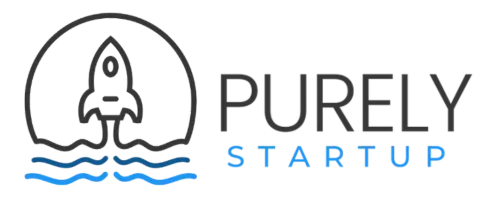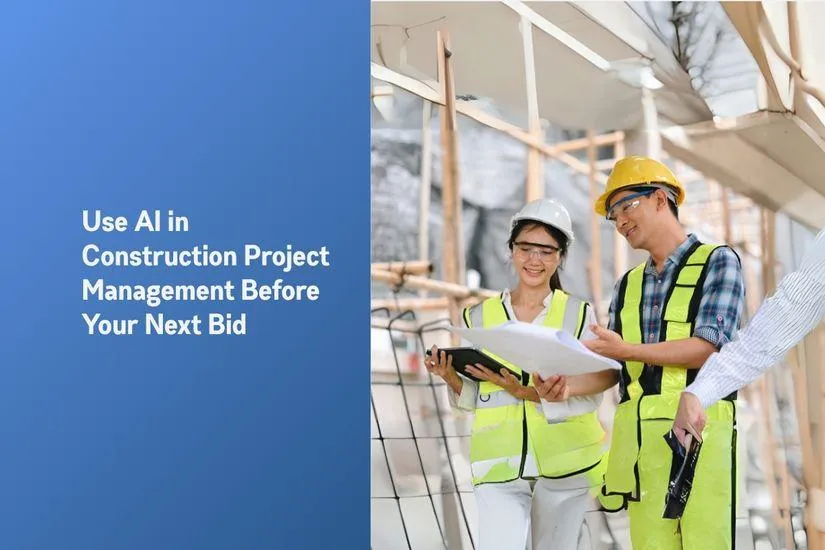
Use AI in Construction Project Management Before Your Next Bid
Last year, I met a construction project manager who spent hours wrestling with outdated spreadsheets and late reports. He told me, “If I could just see what’s happening in real-time, I’d sleep better.” That’s where AI in construction project management comes in.
Instead of relying on guesswork, teams can now use smart tools to track progress, predict costs, and prevent delays before they begin. If you’re tired of always putting out fires instead of staying ahead, you’re not alone.
Let’s look at what AI can do for your projects and why it’s quickly becoming essential in construction management.
Use AI in Construction Project Management Before Your Next Bid
What Is AI in Construction Project Management?
Advantages of AI in Construction Project Management
How AI Transforms Planning and Scheduling
AI is Making Construction Costs More Accurate
How Does AI Help Track Construction Progress in Real-Time?
Can AI Predict and Prevent Job Site Accidents?
How Does AI Make Construction Teams Communicate Better?
How Is Generative AI Changing Design and Documentation?
How Can You Overcome AI Adoption Challenges?
Future of Construction Projects
What Is AI in Construction Project Management?
Artificial Intelligence (AI) in construction project management means using smart computer systems to analyze data, predict outcomes, and automate tasks across a project’s lifecycle. AI helps teams plan, monitor, and optimize construction work more accurately and efficiently. Unlike basic automation, which follows set rules to perform repetitive tasks, AI can learn from patterns and improve over time.
According to McKinsey, AI can boost construction productivity by up to 50% through better forecasting, scheduling, and real-time insights. For example, automation updates a task status. AI goes further by predicting delays, finding the cause, and recommending fixes before issues grow.
There are three main types of AI you’ll find on job sites:
Machine Learning: This analyzes historical data to predict costs, timelines, and risks.
Generative AI: Helps automatically create designs, models, or schedules.
Predictive Analytics: Spots patterns to forecast issues early.
👉 Tired of missed deadlines and chaos on site? Master construction project management with strategies that actually work.
Advantages of AI in Construction Project Management
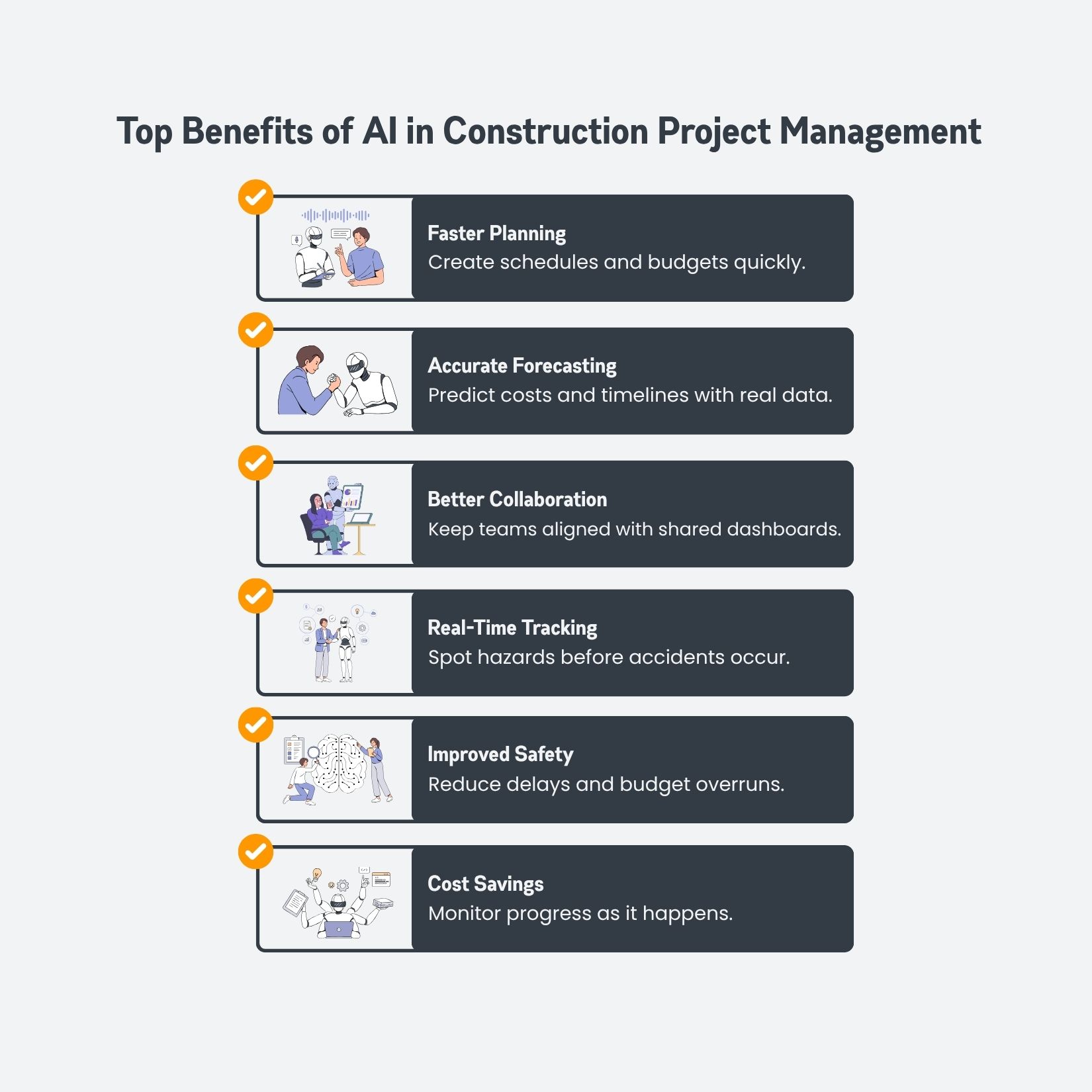
AI isn’t a tech trend; it delivers real benefits that traditional tools can’t match. Here’s why more construction firms are investing in AI:
Faster, Smarter Planning: AI creates accurate schedules and budgets by analyzing thousands of past projects. This helps you spot risks before they turn into delays or overruns.
Better Collaboration: With AI, everyone works from the same up-to-date data. That means fewer miscommunications and smoother handoffs between teams.
Real-Time Progress Tracking: AI tools connect sensors, drones, and software so you always know what’s happening on-site. You can catch issues early and adjust quickly.
Improved Safety: AI systems can predict hazards, monitor worker behaviour, and send alerts to prevent accidents.
Cost Savings: By reducing errors and improving forecasting, AI helps keep projects on budget and often delivers higher profit margins.
How AI Transforms Planning and Scheduling
Traditional scheduling relies on templates and assumptions that often miss the mark. AI flips this approach by using live project data to create plans you can rely on.
With AI, schedules aren’t static. They adjust automatically when things change on-site. If a delivery gets delayed or a crew falls behind, the system updates your timeline in real-time and shows exactly how that impacts the rest of the project.
AI forecasting tools also learn from thousands of past projects. They predict how long each task will take based on real patterns, not guesses. This helps you spot delays and fix them before they spiral.
Platforms like ALICE Technologies and nPlan take this even further. They can model thousands of different scenarios so you can test options and choose the one that saves the most time and money.
👉 Proposals are your first impression so make them count. Learn how AI is transforming proposal writing in construction so you can win more, stress less.
AI is Making Construction Costs More Accurate
Cost overruns are one of the biggest headaches in construction. AI helps solve this by using predictive models that learn from both past projects and real-time updates.
Instead of relying on static spreadsheets, AI systems analyze thousands of data points like material prices, labour rates, weather patterns, and supply chain trends. This means your estimates aren’t based on guesswork. They reflect what’s happening in the market.
What sets AI apart is its ability to spot hidden risks early. For example, it can flag if a specific supplier has a track record of delays or if certain design changes usually trigger cost spikes. You can adjust plans before those issues drain your budget.
How Does AI Help Track Construction Progress in Real-Time?

Most project managers struggle with outdated reports and slow updates. AI changes this by pulling live data straight from the field.
Drones and sensors capture photos, videos, and environmental readings as work happens. Computer vision then scans this information to spot any deviations from your plans, like missing materials, delays, or safety hazards. All of this data feeds into a single dashboard you can check anytime. No more chasing status reports or guessing what’s happening on site.
AI also automates progress updates and generates clear reports for your team and stakeholders. This means everyone stays aligned and problems get solved faster.
Can AI Predict and Prevent Job Site Accidents?
Construction sites are full of risks: falls, equipment failures, and unsafe conditions. AI gives you tools to spot dangers before someone gets hurt. Predictive safety analytics use data from cameras, sensors, and past incidents to flag patterns linked to accidents.
For example, if workers skip harness checks or enter restricted areas, the system sends instant alerts so you can act fast.
Looking ahead, AI safety tech is evolving fast. Companies are combining computer vision with wearables to monitor fatigue, track movement, and even predict when a worker is likely to get injured. When you add AI to your safety program, you move from reacting after something goes wrong to preventing it in the first place.
How Does AI Make Construction Teams Communicate Better?
Construction teams often juggle dozens of tools, emails, and reports. AI helps bring everything together so people stay on the same page without extra effort.
AI chatbots act like smart assistants. They answer questions, send reminders, and share updates instantly. Instead of waiting hours for a reply, teams get the info they need in seconds.
Smart document management tools powered by AI organize files, track changes, and keep everyone working off the latest version. No more confusion over outdated plans or missing paperwork.
Natural language processing also makes communication clearer. AI can turn complex project data into simple summaries that everyone understands, whether you’re on-site or in the office. When your tools talk to each other and handle the busy work, your team can focus on building without constant back-and-forth.
How Is Generative AI Changing Design and Documentation?

Generative AI takes project planning to a new level by creating drawings, 3D models, and reports automatically.
Instead of starting from a blank screen, designers and engineers can feed project specs into AI tools. The system then produces multiple design options in minutes. You can tweak layouts, compare ideas, and pick the best version faster than ever.
For architects, this means less time drafting and more time refining details. Engineers can run simulations early, spotting problems before they hit the field. Project managers get clear, updated documentation without waiting for manual revisions.
When you’re evaluating generative AI platforms, look for tools that integrate with your existing design software, allow real-time collaboration, and export files in formats your teams already use. To put it simply, generative AI doesn’t just save time; it helps teams build smarter with fewer errors and clearer plans.
How Can You Overcome AI Adoption Challenges?
Even the best AI tools won’t deliver results if you don’t prepare for the hurdles that come with them.
Data readiness: AI relies on clean, structured data to work well. Many construction firms have scattered records in different formats, making integration tricky. A good first step is to audit your data and invest in platforms that can connect your systems.
Change management is another roadblock. People often resist new technology because it feels complex or threatens their routines. Clear training and small pilot projects can help teams build confidence without feeling overwhelmed.
Cost versus long-term value: AI requires upfront investment, both in software and skills. But when you look at reduced delays, fewer errors, and better forecasting, the returns can far outweigh the costs over time.
Future of Construction Projects
AI is moving fast, and what feels cutting-edge today will soon be standard on job sites.
Autonomous machinery is one area growing quickly. Self-driving equipment can already handle tasks like excavation, grading, and material transport with minimal supervision. This saves labour costs and improves safety.
AI-driven sustainability: Tools are emerging that measure carbon impact, optimize material use, and design energy-efficient buildings from day one. As green standards tighten, this technology will become even more important.
Role of the project manager: Instead of spending hours updating spreadsheets and chasing reports, managers will focus on interpreting AI insights and leading strategy. Soft skills, such as communication and decision-making, will matter more than ever.
👉 Feeling uneasy about AI on the job site? This article breaks down what project managers really need to know and how to stay relevant.
Your Roadmap to Adopting AI in Construction
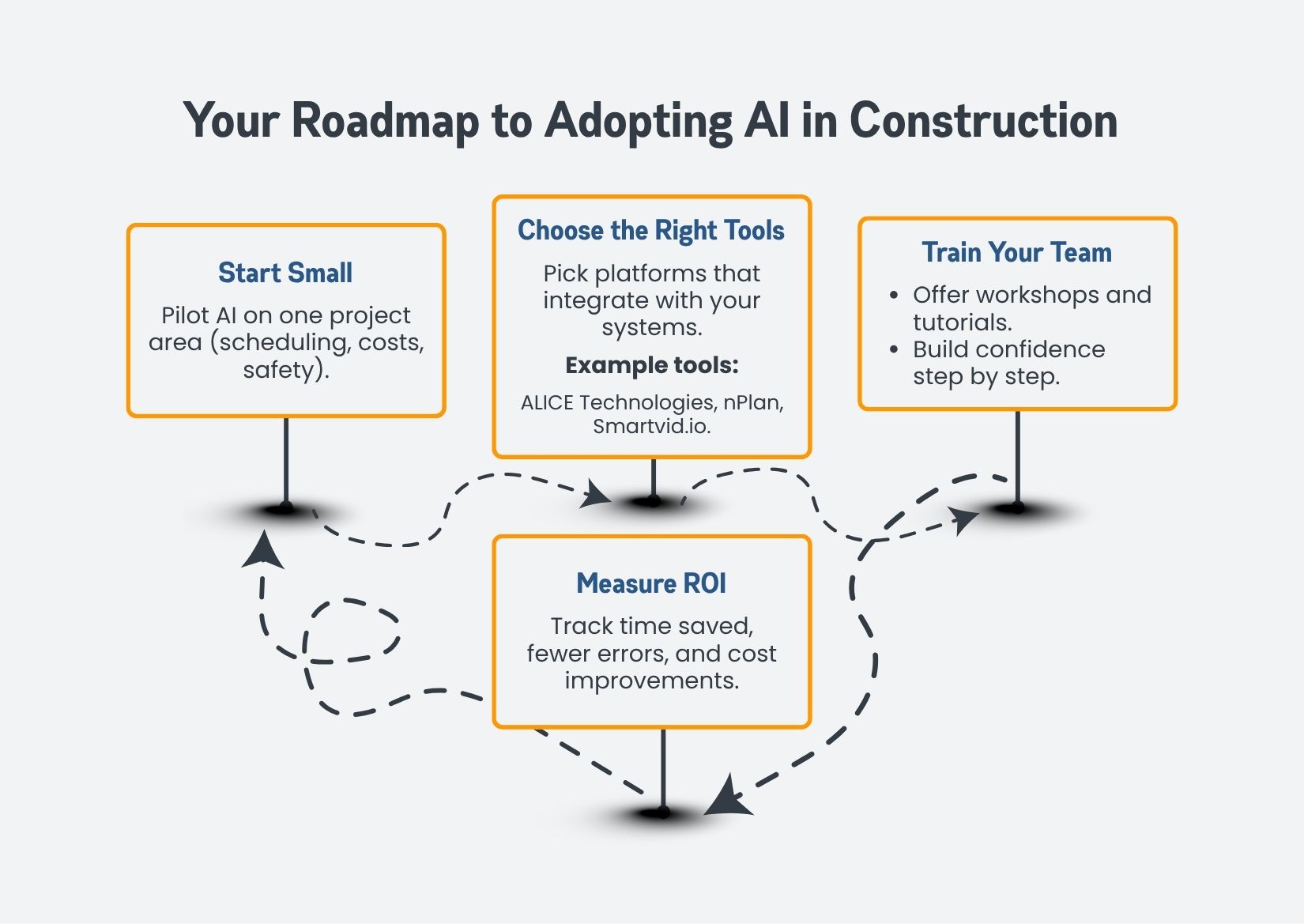
This step-by-step approach helps you test what works and build confidence across your team.
1. Start Small With a Pilot
Pick one area, like scheduling, cost estimation, or safety monitoring, and test an AI tool on a limited project. This helps you measure results without committing to a full rollout.
2. Choose the Right Platforms
Look for software that:
Integrates with your current systems (like BIM or ERP tools)
Has strong user support and training resources
Offers clear reporting dashboards
Some popular options include:
nPlan for risk forecasting
ALICE Technologies for generative scheduling
Smartvid.io for safety monitoring
3. Train Your Team
Offer workshops and tutorials so everyone understands how AI fits into their daily work. When people see the benefits firsthand, adoption improves.
4. Measure ROI Early
Track metrics like time saved, error reduction, and cost improvements. Even small wins can justify scaling AI across more projects.
By starting simple and building momentum, you’ll be ready to use AI confidently and see real results faster.
👉 Think AI is just hype? Discover how smart teams are using AI in construction management to cut costs, avoid delays, and stay ahead of the game.
Final Word From Purely Startup
AI in construction project management is no longer just a future promise. It’s a practical way to plan smarter, save money, and deliver projects with fewer headaches. From real-time progress tracking to predictive cost estimates and safer job sites, AI helps you turn complex challenges into clear solutions.
If you’re ready to see how these tools can fit into your workflows and give your business an edge, book a free consultation with PurelyStartup today.
We’ll help you explore the right AI solutions for your projects and get started with confidence.
